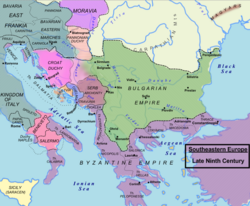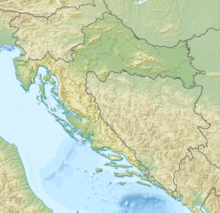Siege of Ragusa (866–868)
| Siege of Ragusa | |||||||||
|---|---|---|---|---|---|---|---|---|---|
| Part of the Arab–Byzantine wars | |||||||||
 Political map of the Balkans and southern Italy in the late 9th century | |||||||||
| |||||||||
| Belligerents | |||||||||
|
Ragusa Byzantine Empire |
Aghlabid Emirate of Bari | ||||||||
| Commanders and leaders | |||||||||
| Niketas Ooryphas |
Kalfun the Berber | ||||||||
| Strength | |||||||||
|
unknown (Ragusa) 100 ships (Byzantines) | 36 ships | ||||||||
Location within Croatia | |||||||||
The siege of Ragusa (modern
Background
At the beginning of the reign of
Siege and aftermath
According to Basil I's grandson, the 10th-century emperor
This expedition was the first example of the new, assertive foreign policy that Basil favoured in the West.[7] Ooryphas' "showing of the flag" had swift results, as the Slavic tribes sent envoys to the Emperor, once more acknowledging his suzerainty. Basil dispatched officials, agents and missionaries to the region, restoring Byzantine rule over the coastal cities and regions in the form of the new theme of Dalmatia, while leaving the Slavic tribal principalities of the hinterland largely autonomous under their own rulers; the Christianization of the Slavic tribes also began at this time.[7][8]
To secure his Dalmatian possessions and control of the Adriatic, Basil realized that he had to neutralize the Saracen bases in Italy. To this end, in 869, Ooryphas led another fleet, including ships from Ragusa which ferried Slavic contingents, in a joint effort to capture Bari with Louis II of Italy. Although this attempt failed, two years later Bari fell to Louis. Finally, in 876 the city came under Byzantine control, forming the capital and nucleus of a new Byzantine province, the later theme of Longobardia. This began a more than decade-long Byzantine offensive that restored imperial control over most of southern Italy, that would last until the 11th century.[9]
References
- ^ a b Wortley 2010, p. 142.
- ^ Nicol 1988, p. 30.
- ^ In reality the name of the founder of the emirate of Bari. Metcalfe 2009, p. 20
- ^ Moravscik & Jenkins 1967, p. 127.
- ^ Wortley 2010, pp. 142–143.
- ^ Moravscik & Jenkins 1967, pp. 127, 129.
- ^ a b Nicol 1988, p. 31.
- ^ Wortley 2010, p. 143.
- ^ Kreutz 1996, pp. 41–45, 57, 63–66, 68.
Sources
- Kreutz, Barbara M. (1996). Before the Normans: Southern Italy in the Ninth and Tenth Centuries. Philadelphia: University of Pennsylvania Press. ISBN 0-8122-1587-7.
- Metcalfe, Alex (2009), The Muslims of medieval Italy, Edinburgh: Edinburgh University Press, ISBN 978-0-7486-2008-1
- Moravscik, Gyula; Jenkins, R.J.H., eds. (1967). Constantine Porphyrogenitus: De Administrando Imperio. Washington, DC: Dumbarton Oaks. ISBN 0-88402-021-5.
- ISBN 0-521-34157-4.
- Wortley, John, ed. (2010). John Skylitzes: A Synopsis of Byzantine History, 811–1057. Cambridge: Cambridge University Press. ISBN 978-0-521-76705-7.


